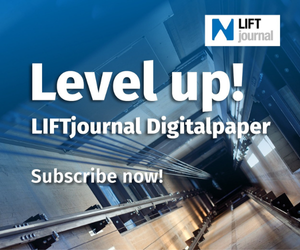Ropes as lifting gear in lifts
To design rope drives in lifts, it is in many cases still indispensable to this day to conduct experimental investigations into sample ropes, for example to determine elongation behaviour in the longitudinal rope direction.
Since its establishment, the Institute of Mechanical Handling and Logistics (IFT) of the University of Stuttgart has been engaged in research in the field of rope technology.
In many modern lifts, ropes as lifting gear are a decisive factor for the service life and maintenance intensity of the entire system. The rope not only has to be wear-resistant, but also reliably indicate its wear condition and above all the replacement state of wear. The replacement state of wear of the rope - i.e. permanent damage - has been reached when the system still operates safely, but an unsafe condition could be reached in the near future.
Important parameter for lift ropes
Spontaneous damage to the rope can for example also occur due to external mechanical factors – this frequently occurs in the area of crane construction. By contrast, ropes in lifts usually wear out on account of over-rolling of the discs. What is important in this regard is clear and reliable indication of the so-called replacement state of wear, the time of rope replacement.
Furthermore, an excessively high modulus of elasticity (e-modulus) can stretch the rope under the load of the car too much and as a result trigger a very uncomfortable sinking of the car upon entry and regulation problems in the travel drive.
A change in the modulus of elasticity and as a result in the rope elongation behaviour during the rope’s service lift can be even more problematic. Apart from the service life of the lifting gear, the modulus of elasticity is an important parameter for lift ropes and should be determined according to application.
Experiments to determine the rope modulus of elasticity
The IFT (see box) regularly conducts experiments on the institute’s own traction testing machinery to measure the modulus of elasticity. There is no linear progression in the rope stress-rope strain curve for the rope’s strength. Consequently, it is very important during the measurement to take into account the use of the rope and the associated rope forces that occur.
For example, for the rope tensile forces, safety factors between 14 and 25 for the lifting gear are normally used. At the IFT, three measuring rigs are available for strain measurement of the rope for various force ranges, installed in two tensile testing machines (for example, in Fig. 1). Measurements can either be conducted by a parallel rod clamped on the rope at two measuring points or by two rope displacement pickups evaluated in parallel (shown in Fig. 1). The result of the measurement is a stress-strain diagram (Fig. 2).
Difference between loading and load reduction
Normally, the secant modulus of elasticity according to Feyrer [1] is determined in the experiment (yellow in Fig. 2). For this purpose, the rope is extended between the minimum and maximum rope loads occurring in the operation of the rope, that is to say, run to the upper and lower limit load several times in succession. After this, the tenth extension cycle for example is evaluated – the rope extension is determined from the measurement log while running past the two observation limits.
In addition to the secant modulus, the tangent modulus (shown red in Fig. 2) can also be determined from the intersections of the elongation curves with the observation limits. In each case, the difference between loading and load reduction is important, since as a result of inner friction in the rope, the elasticity behaviour can in part differ markedly depending on the direction.
Stefan Hecht
The author is a qualified engineer and head of the research group Destructive Rope Testing of the Institute of Materials Handling and Logistics (IFT) of the University of Stuttgart.
[1] Feyrer, K., Wehking, K.-H.: Drahtseile – Bemessung, Betrieb, Sicherheit, Springer Verlag, Berlin, 2018
Since its establishment in 1927, the Institute of Mechanical Handling and Logistics (IFT) of the University of Stuttgart has been engaged in research in the field of rope technology. The rope technology department concentrates on wire ropes, fibre ropes, personal protective equipment, cableway technology and rope use.
It provides studies to determine rope service life in continuous bending fatigue and extension experiments, static and dynamic experiments, drawing up damage expert opinions, safety and risk analyses, cableway technology and destructive and non-destructive rope testing. Furthermore, the IFT advises industrial companies as well as the operators of installations and buildings on the specific use of ropes.
The department is recognised worldwide as a testing and expert opinion authority. The over 1300 m² experiment hall at the IFT, the rope laboratory, is equipped with testing machinery and installations for rope testing, in part developed at the laboratory itself.





















Write a comment